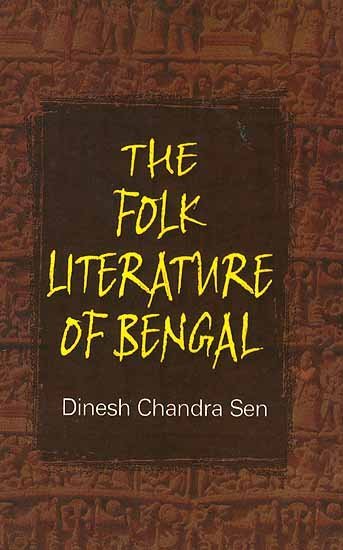Folk Tradition of Bengal (and Rabindranath Tagore)
by Joydeep Mukherjee | 2018 | 49,317 words | ISBN-10: 8186036989 | ISBN-13: 9788186036983
An English study regarding the Folk Tradition of Bengal and its influence on Rabindranath Tagore—an important Bengali polymath from the 19th century who excelled in philosophy, arts (painting), literature and music. This research tries to initiate the semantic aspect of “folk” through the help of various dictionaries....
Chapter 2.1 - Tagore as Baul and his Infinite Thoughts
[Full title: Review of Research—Rabi Baul O Tar Bichitra Bhabana (Tagore as Baul and his Infinite Thoughts)]
The little of the book denotes Tagore as Ravi Baul and his facets of feelings for them. The writer Ahmed Rafique is the founder of Rabindra cultural trust (Rabindra Charcha Kendra Trust). He is also associated with ‘Asiatic Society’. Tagore is a common interest for him from all respects. This book is renowned book among those who accepted Tagore as the sum mum bonum. He is noted for his research work which attributed him awards like “Rabindratattacharya” (Master on the theory Tagore) from ‘Tagore Research Institute’, Kolkata and in 1418 (according to Bengali year) he was honoured with another prestigious award ‘Rabindra Puroshkar (Award)’.
This book is a collection of some essays regarding folk song in undivided Bengal, aftermath devision and regarding Tagore on different topics. All these essays are compiled under the title of “Ogronthitho Rabindranath” (Unpublished Rabindranath). But certainly the beginning past is the most catchy when he tittles it as “Rabindra Bauler Aktarate” (In the Aktara of Rabindranath or Tagore with Baul’s Aktara). Besides Tagore related issues, the writer has shown a keen interest to draw a line between Rabindranath Tragore and Nazrul Islam, another star in the spectrum of Bengal.
This book, a collection of essays, also focuses on various aspects of Rabindranath Tagore namely:
- “Rabindranath: Tar Valobasai Nari” (Rabindranath in Consideration of Women in Love),
- “Rabindra Chaitanye Boiporitter Dwimatrikata” (Duality of Oppositeness in the Consciousness of Rabindranath),
- “Tarunyer Joyodhwani-Konthe Chute Chola Dui Kobi” (Two Young Poets Moving in the Triumphant Race),
- “Borsha Bornoner Rupochitrakar Rabindranath” (Rabindranath as a Great Painter of Rain),
- “Baishakher Prakrito Rupe Rabindrik Pangtir Bastabata” (The Relevance of the Lines of Rabindranath on the Real Nature in the Month of Baishak),
- “British Songbadpotre Baishe Sharbon Prosongo” (The Reference of 22nd Sharabon in British Newspaper),
- “Kobir Bigyanchinta” (The Scientific Thought of Rabindranath),
- “Bishnu Dey r Kobitai Rabindranath” (Rabindranath in the Poems of Bishnu Dey) etc.
In this book the writer stated the research done by Tagore to find out the reality in them. Surprisingly he is successful to combine both the strings of romanticism and aestheticism. That is why the presence of Baul as an integral part of his work is not at all unexpected but rather evokes a sense of mystery and caters curiosity among his readers. The writer here is much focused on his power of assemblance between Bauls and Upanishad. Therefore, he stated that the complex theoretical aspect is not at all a point of confrontation for him but rather a point of confluence of these two ideas. To illustrate his ideas, he especially referred to ‘Chitra’, ‘Falguni’ and other books on Rabindranath by different writers such as Buddhadev Basu, Prashanta Kumar Pal, Shaktinath Jha and others.
To relate his conception with “Andha Baul” (Blind Baul) he refers to Prashanta Kumar Paul from his “Rabi Jibani” (Life of Rabi), 7th part:
The dramatic motif crystallises at the appearance of the blind singer. The author has taken upon himself the most difficult role of the opera... The dialogue with the blind singer is carried on in a great style of mystic art which is the largest feature of the poet (p. 136).
Here he emphasised on mystic Art of Tagore which is very dominant in him.
Mainly the book focused one typical idea of ‘Rabi Baul’. Here he tried to share that this initiative is due to his extreme attempt to feel as one of them. The poet tries to travel back to his root and own tradition instead of traversing the world. The writer has informed that he did his best to understand the walk of their lives, the scope of their lives and over all the beauty of their lives. The writer categorically mentioned that as a part of the universe, Tagore felt the loneliness with his own structure and consequently ransacked the ultimate with his own identity / rather through the identity of a Baul.
After that in the second part of the same essay he touched the discourse of moner manush. One interesting aspect is quite interesting when the writer explains his moner manush in terms of feminine identity. Truly in a number of songs and poems, he invariably includes several unknown lady characters. Very minutely the writer / essayist twisted about their identities by saying that they may be his “Aparichita” (unknown). Here the essay also mentioned his ecstatic quality of romanticism.
3rd and 4th part of the essay are very small dealing the post effect of such identical conversation. The poet becomes more and more erratic without their presence and turns out to be fanatic to listen to them “Ami kan pete roi” (Translation: I am ready to listen to them) to search in him.
